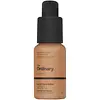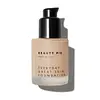What's inside
What's inside
 Key Ingredients
Key Ingredients

 Benefits
Benefits

No benefits
 Concerns
Concerns

 Ingredients Side-by-side
Ingredients Side-by-side

Cyclopentasiloxane
EmollientWater
Skin ConditioningCaprylyl Methicone
Skin ConditioningCoconut Alkanes
EmollientTrimethylsiloxysilicate
EmollientPEG-9 Polydimethylsiloxyethyl Dimethicone
EmulsifyingCoco-Caprylate/Caprate
EmollientDimethicone/PEG-10/15 Crosspolymer
Cetyl Diglyceryl Tris(Trimethylsiloxy)Silylethyl Dimethicone
Emulsion StabilisingDipropylene Glycol
HumectantTocopherol
AntioxidantPolyglyceryl-3 Diisostearate
EmulsifyingPolyglyceryl-3 Polyricinoleate
EmulsifyingPolyglyceryl-4 Isostearate
EmulsifyingDisteardimonium Hectorite
StabilisingHectorite
AbsorbentSodium Chloride
MaskingHexyl Laurate
EmollientDimethicone/Vinyl Dimethicone Crosspolymer
Skin ConditioningPEG-10 Dimethicone
Skin ConditioningStearic Acid
CleansingMethyl Methacrylate Crosspolymer
Alumina
AbrasiveTrisodium Ethylenediamine Disuccinate
Phenoxyethanol
PreservativeChlorphenesin
AntimicrobialCI 77891
Cosmetic ColorantIron Oxides
Tin Oxide
AbrasiveAluminum Hydroxide
EmollientCI 77163
Cosmetic ColorantMica
Cosmetic ColorantMagnesium Stearate
Cosmetic ColorantTriethoxycaprylylsilane
Cyclopentasiloxane, Water, Caprylyl Methicone, Coconut Alkanes, Trimethylsiloxysilicate, PEG-9 Polydimethylsiloxyethyl Dimethicone, Coco-Caprylate/Caprate, Dimethicone/PEG-10/15 Crosspolymer, Cetyl Diglyceryl Tris(Trimethylsiloxy)Silylethyl Dimethicone, Dipropylene Glycol, Tocopherol, Polyglyceryl-3 Diisostearate, Polyglyceryl-3 Polyricinoleate, Polyglyceryl-4 Isostearate, Disteardimonium Hectorite, Hectorite, Sodium Chloride, Hexyl Laurate, Dimethicone/Vinyl Dimethicone Crosspolymer, PEG-10 Dimethicone, Stearic Acid, Methyl Methacrylate Crosspolymer, Alumina, Trisodium Ethylenediamine Disuccinate, Phenoxyethanol, Chlorphenesin, CI 77891, Iron Oxides, Tin Oxide, Aluminum Hydroxide, CI 77163, Mica, Magnesium Stearate, Triethoxycaprylylsilane
Water
Skin ConditioningCyclopentasiloxane
EmollientDimethicone
EmollientAlcohol
AntimicrobialEthylene/Acrylic Acid Copolymer
Emulsion StabilisingPEG-4
HumectantHdi/Trimethylol Hexyllactone Crosspolymer
Polysorbate 20
EmulsifyingPEG-10 Dimethicone
Skin ConditioningIsononyl Isononanoate
EmollientDisteardimonium Hectorite
StabilisingTrimethylsiloxysilicate
EmollientCaprylyl Dimethicone Ethoxy Glucoside
EmulsifyingDimethicone/Vinyl Dimethicone Crosspolymer
Skin ConditioningMyristyl Lactate
EmollientPhenoxyethanol
PreservativeSodium Chloride
MaskingBenzyl Alcohol
PerfumingSynthetic Fluorphlogopite
Sodium Dehydroacetate
PreservativeAluminum Hydroxide
EmollientTocopheryl Acetate
AntioxidantCetyl Dimethicone
EmollientSilica
AbrasiveStearoyl Inulin
EmollientDisodium EDTA
Sodium Lauroyl Glutamate
Lysine
Skin ConditioningTriethoxycaprylylsilane
Titanium Dioxide
Cosmetic ColorantCI 77491
Cosmetic ColorantCI 77492
Cosmetic ColorantCI 77499
Cosmetic ColorantWater, Cyclopentasiloxane, Dimethicone, Alcohol, Ethylene/Acrylic Acid Copolymer, PEG-4, Hdi/Trimethylol Hexyllactone Crosspolymer, Polysorbate 20, PEG-10 Dimethicone, Isononyl Isononanoate, Disteardimonium Hectorite, Trimethylsiloxysilicate, Caprylyl Dimethicone Ethoxy Glucoside, Dimethicone/Vinyl Dimethicone Crosspolymer, Myristyl Lactate, Phenoxyethanol, Sodium Chloride, Benzyl Alcohol, Synthetic Fluorphlogopite, Sodium Dehydroacetate, Aluminum Hydroxide, Tocopheryl Acetate, Cetyl Dimethicone, Silica, Stearoyl Inulin, Disodium EDTA, Sodium Lauroyl Glutamate, Lysine, Triethoxycaprylylsilane, Titanium Dioxide, CI 77491, CI 77492, CI 77499
Ingredients Explained
These ingredients are found in both products.
Ingredients higher up in an ingredient list are typically present in a larger amount.
Aluminum Hydroxide is a form of aluminum. It can be naturally found in nature as the mineral gibbsite. In cosmetics, Aluminum Hydroxide is used as a colorant, pH adjuster, and absorbent.
As a colorant, Aluminum Hydroxide may add opacity, or reduce the transparency. Aluminum hydroxide is contains both basic and acidic properties.
According to manufacturers, this ingredient is an emollient and humectant. This means it helps hydrate the skin.
In medicine, this ingredient is used to help relieve heartburn and help heal ulcers.
There is currently no credible scientific evidence linking aluminum hydroxide in cosmetics to increased cancer risk.
Major health organizations allow the use of aluminum hydroxide in personal care products and have not flagged it as a carcinogenic risk at typical usage levels.
Learn more about Aluminum HydroxideCyclopentasiloxane, or D5, is a silicone used to improve texture of products and trap moisture.
D5 is considered lightweight and volatile. Volatile means it evaporates quickly after application. Once evaporated, D5 leaves a thin barrier that helps keep skin hydrated.
It is also an emollient. Emollients help soften the skin and prevent water loss. Silicones create a silky texture in products. D5 helps other ingredients become more spreadable.
Studies show D5 is safe to use in skincare products. We recommend speaking with a skincare professional if you have concerns.
Learn more about CyclopentasiloxaneThis ingredient is a silicone used to improve the texture of products and absorb oil. It does not get absorbed into the skin.
Like other silicones, Dimethicone/Vinyl Dimethicone Crosspolymer helps condition the skin by creating a barrier. In this sense, it can act as an emollient and trap moisture in.
This ingredient is a type of elastomer.
Learn more about Dimethicone/Vinyl Dimethicone CrosspolymerDisteardimonium Hectorite comes from the clay mineral named hectorite. It is used to add thickness to a product.
It can also help stabilize a product by helping to disperse other ingredients.
Hectorite is a rare, white clay mineral.
Learn more about Disteardimonium HectoritePeg-10 Dimethicone is silicone with conditioner and emulsifier properties. It mostly acts as an emollient in skincare and and humectant in haircare.
According to the manufacturer, acidic formulations decrease the stability of this ingredient. It works best in neutral or near neutral formulations.
Phenoxyethanol is a preservative that has germicide, antimicrobial, and aromatic properties. Studies show that phenoxyethanol can prevent microbial growth. By itself, it has a scent that is similar to that of a rose.
It's often used in formulations along with Caprylyl Glycol to preserve the shelf life of products.
Chances are, you eat sodium chloride every day. Sodium Chloride is also known as table salt.
This ingredient has many purposes in skincare: thickener, emulsifier, and exfoliator.
You'll most likely find this ingredient in cleansers where it is used to create a gel-like texture. As an emulsifier, it also prevents ingredients from separating.
There is much debate on whether this ingredient is comedogenic. The short answer - comedogenic ratings don't tell the whole story. Learn more about comegodenic ratings here.
The concensus about this ingredient causing acne seems to be divided. Research is needed to understand if this ingredient does cause acne.
Scrubs may use salt as the primary exfoliating ingredient.
Learn more about Sodium ChlorideTriethoxycaprylylsilane is a silicone used to bind and stabilize ingredients.
As an emulsifier, it helps prevent ingredients from separating. This can help elongate the shelf life of products.
Triethoxycaprylylsilane is often used to coat mineral sunscreens ingredients to help give a better feel. It also helps reduce oxidative stress in sunscreens.
Learn more about TriethoxycaprylylsilaneThis silicone is an emollient. Emollients create a thin film on the skin to prevent moisture from escaping.
It is not soluble in water and helps increase water-resistance in products.
According to a manufacturer, it can blend seamlessly with silicone oils, such as Cyclopentasiloxane.
Learn more about TrimethylsiloxysilicateWater. It's the most common cosmetic ingredient of all. You'll usually see it at the top of ingredient lists, meaning that it makes up the largest part of the product.
So why is it so popular? Water most often acts as a solvent - this means that it helps dissolve other ingredients into the formulation.
You'll also recognize water as that liquid we all need to stay alive. If you see this, drink a glass of water. Stay hydrated!
Learn more about Water